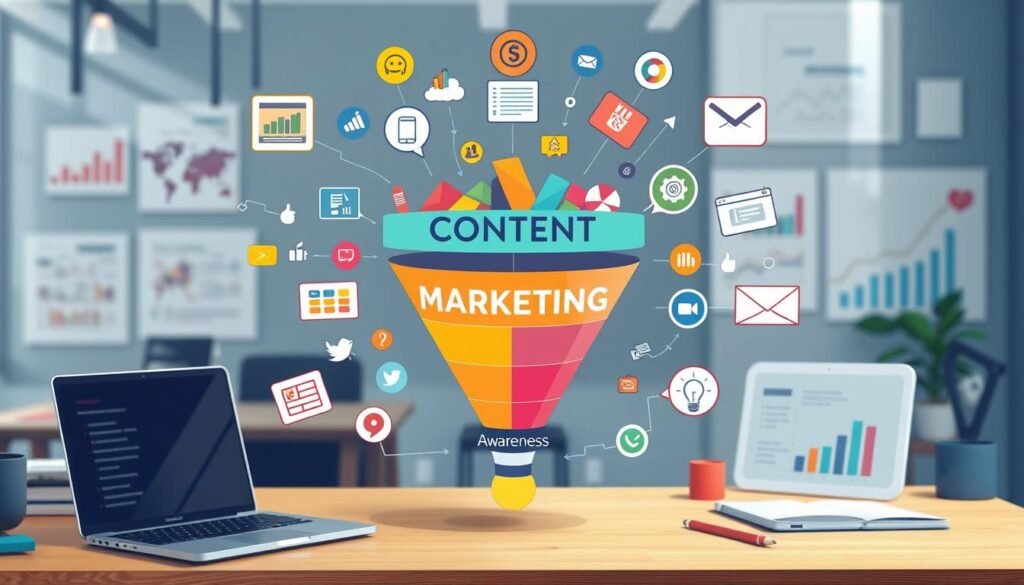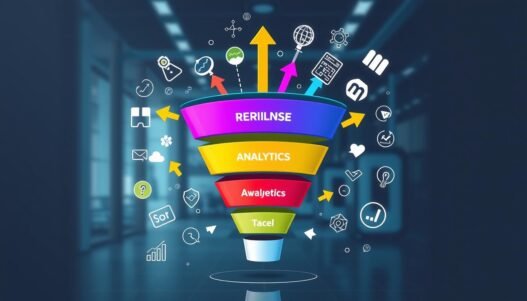Did you know that just one tweak in your sales funnel can boost conversion rates by 300%12?
This fact highlights the key role of sales funnel optimization in marketing success. In today’s world, where distractions abound, grasping the sales funnel’s details is vital. By improving each step, from awareness to loyalty, you can overcome performance hurdles and boost revenue.
Businesses focusing on customers need to understand their behavior and likes. Using retargeting ads and clear calls to action can greatly improve visitor interaction and lower abandonment rates12. Also, constant testing and analysis, like A/B testing, are crucial for fine-tuning your efforts1. This article will explore sales funnel optimization, offering you actionable tips to boost your conversion rates.
Key Takeaways
- The right optimization strategies can increase conversion rates significantly.
- Understanding customer behavior is paramount for a successful sales funnel.
- Utilizing retargeting ads can effectively bring back lost visitors.
- Regular A/B testing helps optimize your funnel performance.
- Effective CTAs are critical in driving conversions.
Understanding the Sales Funnel
The sales funnel is a key tool that shows how a potential customer moves from learning about a product to buying it. It has different stages that match the customer’s journey. Knowing about the sales funnel helps marketers improve how they turn leads into customers.
Definition of a Sales Funnel
A sales funnel has several marketing stages. It starts with awareness, where people first see a brand. Then, they move to interest, desire, and finally, action, or buying. A good sales funnel helps track how many leads become paying customers3.
The Importance of a Sales Funnel in Marketing
Marketers need to understand the sales funnel to improve their plans. They must look at how long leads stay in each stage to see how efficient they are3. It’s also key to follow up with prospects to see how many engage with the first marketing efforts3. Each part of the funnel offers chances to make the customer experience better through personalized messages.
| Stage | Description | Key Metrics |
|---|---|---|
| Awareness | Initial exposure to the product or service | Entrances, Website Visitors |
| Interest | Potential customers show interest in the offering | Engagement Levels, Follow-ups |
| Consideration | Lead evaluating the product or service | Conversion Rate, Win Rate |
| Intent | Leads prepared to make a purchase decision | Total Revenue, Average Order Value |
| Purchase | Completion of the transaction | Customer Lifetime Value, Overall Sales Efficiency |
The Stages of the Sales Funnel
The sales funnel journey has different stages. These stages help guide potential customers from first learning about a product to becoming loyal customers. Knowing these sales funnel stages helps businesses create better marketing plans to meet customer needs.
Awareness Stage
The awareness stage is key. It’s when people first hear about a product or service. Brands need to show how they can solve customers’ problems with good content. This content should be engaging and informative to spark interest in the brand4.
Consideration Stage
In the consideration stage, people start looking at their options. They might fill out forms or sign up for emails. Content like testimonials and reviews can help them make up their minds. It’s also a good time to move leads from marketing to sales4.
Conversion Stage
The conversion stage is when people are ready to buy. Using special offers and email campaigns can help seal the deal. The content should be strong and answer any questions to build trust4 and5.
Loyalty Stage
The loyalty stage is all about keeping customers coming back. Brands should show related products and offer subscriptions. Engaging with customers after a purchase can lead to more sales and brand advocates4 and5.
| Stage | Description | Key Focus |
|---|---|---|
| Awareness | Initial Discovery | Quality Content |
| Consideration | Evaluating Options | Influencing Through Testimonials |
| Conversion | Making a Purchase | Effective Offers |
| Loyalty | Building Relationships | Ongoing Engagement |
Identifying Your Target Audience
Knowing your target audience is key to a successful sales funnel. By creating buyer personas, businesses can tailor their approach to specific groups. This helps in making marketing strategies that really speak to potential customers.
Creating Buyer Personas
Buyer personas are like ideal customer profiles, made from real data. Tools like Meta’s Business Manager give insights into who your audience is6. Surveys with high-value customers also help make these profiles more accurate6.
Segmenting your Audience for Better Engagement
Segmenting your audience means making messages that really hit home. Google Analytics helps see what visitors like, guiding your targeting6. You can segment by many things, like who they are, what they like, and how they act. For example, targeting ads better can boost your return on investment, like in eCommerce7. Tools on ad platforms can find new customers who are like your current ones6.
| Segment Type | Description | Benefits |
|---|---|---|
| Demographic Segmentation | Segments based on age, gender, income, etc. | Helps tailor marketing messages to specific demographics |
| Psychographic Segmentation | Focuses on interests, values, and lifestyles | Enhances personal connection with the brand |
| Behavioral Segmentation | Based on consumer behaviors and purchasing patterns | Improves targeting strategies leading to higher conversion rates |
| Geographic Segmentation | Segments according to geographic location | Tailors content based on regional preferences |
Crafting Compelling Content for Each Funnel Stage
To make effective content marketing, you need to know your audience well. You must engage them with content that meets their needs. This keeps them interested and moving through the sales funnel.
Awareness-Stage Content Strategies
At the awareness stage, people start to see a need or problem. It’s key to offer helpful and informative content. Since 70% of buyers check Google for product info, it’s vital to rank well for keywords8.
Blog posts, infographics, and videos are great for grabbing attention. They help people dive deeper into what you offer.
Consideration-Stage Content Development
In the consideration stage, people want more detailed info. Studies say content should be over 1,500 words to give good insights8. Including customer testimonials is also important, as 61% of buyers value them8.
Offering comparisons, demo videos, and FAQs can help. They make it easier for people to weigh their options.
Conversion-Stage Content Essentials
At the conversion stage, focus on the product’s benefits and unique selling points. Using urgency tactics, like limited stock alerts, can push people to buy9. Marketers see content as crucial, with 60% saying it’s very or extremely important10.
Use strong CTAs and interactive content to help people decide. This drives sales.

Optimizing Your Landing Pages
Landing page optimization is key to boosting conversion rates. A well-designed landing page is a powerful tool for capturing leads and converting visitors. By focusing on design elements, companies can create pages that engage their audience and lead to higher sales.
Design Elements for Success
Clear headings, compelling images, and concise text are crucial for visually appealing landing pages. Making these elements easy to navigate and understand is vital. Research shows that consistent design can increase conversion rates by 66%11.
Effective Copywriting for Landing Pages
Effective copywriting guides visitors through the sales funnel. Strong headlines and persuasive calls to action encourage users to take action. Landing pages optimized with psychological triggers can see a 28% increase in conversion rates11.
Utilizing A/B Testing Techniques
A/B testing is a proven method for refining landing pages. This process allows marketers to test different elements like layout and content. For example, companies have seen a 24% reduction in cost-per-click through A/B testing11.
Continuous discovery methods, like user interviews and heatmaps, track user behavior. They help identify issues that may hinder conversions, ensuring a strategic approach to landing page optimization11.
| Design Elements | Impact on Conversion |
|---|---|
| Clear Headings | Enhance user understanding |
| Compelling Images | Increase emotional engagement |
| Concise Text | Improve readability |
| Consistent Design | Boost conversion rates by 66% |
| Strong CTAs | Encourage user action |
Driving High-Quality Traffic to Your Sales Funnel
Getting high-quality traffic is key to turning leads into customers. Knowing what high-quality traffic is helps focus your marketing.
Understanding High-Quality Traffic
High-quality traffic means visitors who really care about what you offer. They’re likely to buy because they find your content interesting and ads on point. Studies show ads can boost traffic and sales. For example, retargeting ads make people 70% more likely to buy, showing ads’ power in getting leads12.
Creating valuable content also draws more people to your sales funnel13.
Creating Targeted Advertising Campaigns
Targeted ads can bring in better traffic. Sites like Facebook and LinkedIn have tools to find the right people. Facebook ads are getting pricier, showing how competitive ad space is14.
Videos are especially good; they get 7.5 times more clicks than regular ads12. Using LinkedIn Live can get 7 times more reactions and 24 times more comments than usual posts14. This boosts your credibility and awareness, key for your sales funnel.
| Traffic Source | Effectiveness | Conversion Rate |
|---|---|---|
| Social Media | High | Varied (often high with engaging content) |
| Retargeting Ads | Very High | 70% increased likelihood of conversion |
| Video Ads | High | 7.5 times higher click-through rate |
| Content Marketing | High | Effective in driving organic traffic |
Utilizing Strong Calls To Action (CTAs)
Effective calls to action (CTAs) are key to driving conversions in the sales funnel. They encourage users to take action and boost engagement. To craft these CTAs, you need to know what your audience responds to at each funnel stage.
Writing Effective CTAs
CTAs should be short, engaging, and match the content around them. Starting with action verbs can get people moving. For instance, “Download Now” gets users to act, and adding urgency can make them feel they’ll miss out if they don’t act fast15.
Brands like HubSpot and Glossier show that different styles work for different audiences15. Over 90% of site visitors who read a headline will click on the CTA16. A strong headline is crucial for directing attention. Using scarcity in your CTA can also boost conversions16. It’s important to test different CTAs to see what works best.
Positioning and Design of CTAs
Where you place CTAs on a webpage matters a lot. Buttons are the most common type of CTA because they’re simple and effective15. Adding colors and fonts that stand out can make users more likely to click16. Social proof, like testimonials, can also make CTAs more appealing16.
After clicking a CTA, the process should be smooth to keep users engaged16. Form submission CTAs are great because they offer valuable content in exchange for contact info15. Direct communication tools, like click-to-call buttons, are also key for better engagement and lead generation17.
| CTA Type | Purpose | Example |
|---|---|---|
| Button | Encourages immediate action | “Download Now” |
| Pop-up | Captures user attention with offers | “Sign Up for Updates” |
| Slide-in | Less disruptive attention capture | “Join Our Community” |
| Click-to-call | Facilitates direct communication | “Call Us Today” |
Leveraging Social Proof in Your Sales Funnel
In today’s market, social proof is key to a successful sales funnel. It helps build trust and answers potential customers’ concerns. This makes them more likely to buy from you.
Building Trust Through Testimonials
Customer testimonials can make prospects feel safer and more trusting. Real stories that solve problems connect with potential buyers. Seeing these testimonials on your website reminds people of your product’s value18.
With 93% of buyers reading reviews online, adding genuine testimonials boosts your credibility19.
Integrating Reviews and Ratings
Customer reviews and ratings are vital for making buying decisions. About 79% of shoppers let these reviews guide their choices19. Plus, good reviews can make customers spend up to 31% more19.
Using badges and logos from trusted sources shows your expertise. Being active on social media also helps show your brand’s credibility18.

| Type of Social Proof | Impact on Customers | Statistical Insight |
|---|---|---|
| Testimonials | Builds trust and credibility | Customer testimonials can significantly reduce perceived risk18. |
| Online Reviews | Influences purchase decisions | 93% of consumers read online reviews before purchasing19. |
| User-Generated Content | Enhances brand perception | User-generated content can increase conversion rates by 270%19. |
| Social Media Engagement | Boosts brand authority | Engagement metrics help in increasing brand awareness18. |
Conclusion
Understanding and optimizing sales funnels is key to boosting conversions and improving marketing strategies. A sales funnel is more than a simple process. It’s a journey for customers, helping them move from awareness to conversion20. By recognizing this, companies can guide potential buyers better, meeting their needs at every step21.
Effective strategies include creating content that resonates at each stage and using social proof to build trust22. Also, using data to improve the funnel helps businesses adapt to market changes and customer preferences. This leads to more revenue, loyal customers, and increased engagement.
By applying these insights, companies can make every interaction count, leading to long-term success. Embracing sales funnel optimization is a continuous effort. It’s essential for businesses to thrive in today’s competitive market.
















